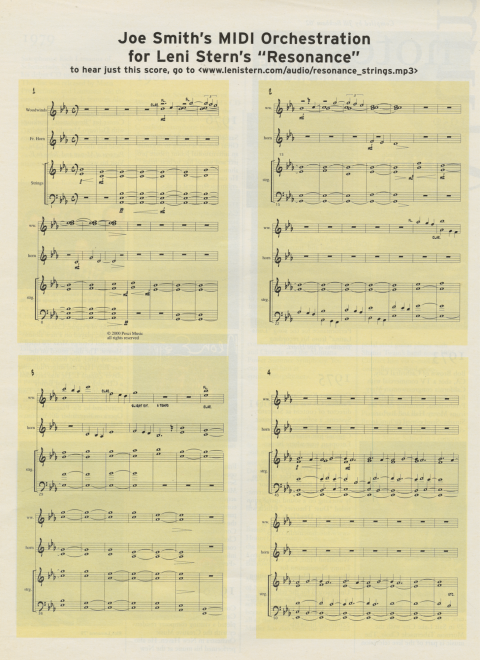Finding the Right Resonance
by Joe Smith

For her latest CD, Kindness of Strangers, composer/guitarist Leni Stern '80 wanted to augment the rhythm and vocal tracks with MIDI orchestral arrangements. She sent me the tracks and told me that I could do whatever I wanted with my arrangements.
For a project of this nature and length, I tend to work intuitively. I start by listening to the tracks a lot. I might spend days thinking about how to approach the arrangements. While I do think very concretely about musical considerations, my main goal is to try to internalize the feeling of the music as much as possible. That helps me to take a very organic approach to the arrangement--one that grows out of a fundamental kernel of the existing music.
This article will focus on the final track of the CD, an instrumental improvisation entitled "Resonance." The instrumentation includes percussion, acoustic bass, electric guitar, and a MIDI orchestra consisting of strings, flute, clarinet, and French horn. [See the links to the MIDI score above.] To hear the score as you read along with this article, go to the web site at <www.lenistern.com/audio/resonance_strings.mp3>. Leni's homepage is at <www.lenistern.com>.
The tune opens with the percussion setting up a groove for six bars. The guitar and bass play out of time. After the mood of the piece is established, the orchestration comes in. (The bar numbers on the score begin at this point.) I made no attempt to match the tempo of the arrangement with the tempo of the tracks. The MIDI arrangement is its own entity, playing at an entirely different tempo and floating over the tracks while enhancing the atmosphere of the piece.
There are two "target points," the first is bar 33 of the MIDI arrangement, where the percussion stops playing time and the guitar becomes more dominant; the original string motive is restated after a contrasting section in the arrangement. The second is at bar 42 of the MIDI arrangement, where the bass emphatically plays the tonic; a floating atmosphere is created in the strings and continues to the end of the piece.
Concept of the Arrangement
The peaceful improvisation by the rhythm section is in the key of E-flat major. For the MIDI arrangement, I took a pandiatonic approach. [Features of pandiatonicism, a twentieth century compositional technique, are the use of a diatonic scale as the source of the work's tonal material without regard for the traditional harmonic functions of chordal structures.] I used notes from the E-flat major scale exclusively; there is no chromaticism. Cadences and tonal function are purposely blurred and ambiguous. (A notable exception to this happens in bars 41 and 42 where there is a familiar-sounding IV-I cadence.)
A tonal center is strongly suggested, particularly when there is a sustained interval of a perfect fifth in the bass. Often the textures above the perfect fifth in the low strings are derived from intervallic relationships that have nothing to do with the suggested tonal function. Melodic motion and motives are not determined by tonal function, and structures sometimes purposely infer a tonal function different from what is implied by the low strings.
The potentially static nature of pandiatonicism is offset in a number of ways. There is slow but constant motion created by the layered entrances of all the instruments, simple counterpoint, and variations in texture created by the development of the slow-moving melodic motives. To create a sense of tension and release, I exploited the relationships between the minor second or major seventh intervals that occur between the third and fourth degrees of the scale (G and Ab) and the first and seventh degrees (Eb and D). In addition, I contrasted the predominantly open textures (those containing mostly perfect fourths and fifths) with thick textures consisting of major and minor seconds.\
Motives and Form
The motif of a perfect fifth descending a third is first heard in the strings in bar 1 of the MIDI arrangement. Above, the layered entrances of the woodwinds in bar 5 form a cluster voicing with a D and Eb. Another flute (third woodwind entrance) echoes the perfect fifth diad of the strings by entering on Bb a perfect fifth above the first flute. This flute line moves down stepwise to an F in bar 8 and becomes part of the woodwind cluster. The French horn, entering on the C a major ninth below the first woodwind entrance, outlines the shape of the moving flute line by rising a perfect fifth and then dropping a perfect fourth. This 10-bar section of melodic and harmonic material in the strings and woodwinds is heard again at a new pitch level in bar 11.
The perfect fifth string motif repeats a third time beginning in bar 20 at a higher pitch level. This section soon becomes canonic, developing the top woodwind line that first appeared in bar 6. The original descending line, Bb, Ab, G, and F, is modified to begin on Ab, descend to G and F, and then ascend to Bb. The rhythm of the line is modified too.
This section ends by overlapping in bar 33 with another statement of the original string motif; this time it is an octave higher than it was in its first entrance. The ensuing section consists of canonic entrances of this simple motif in the high strings, low strings, horns, and woodwinds.
The section ends in bars 41 and 42 with the IV-I cadence described earlier. That leads into the final section of the arrangement, which features changing textures in the upper strings over an Eb pedal in the low strings.
Points of Interest
The blurring of harmonic functions that occurs with pandiatonicism may be perceived in different ways by the ear. Motives in the higher strings combining with textures in the lower strings might be heard as voicings, but in reality, they were the result of the movement of individual lines. For example, in bar 3, the structure might be heard as 1,5,9,3,7 of an Ab major 7 chord. It might, however, be heard as two very open textures being combined. In bars 6-7, the sound of dominant function (suggested by the Bb and D) is combined with the sound of the Ab chord (a subdominant function chord in the key of Eb. Now it's really possible to hear Bb and D over Ab and Eb, particularly because of the wide spacing. When the D moves up to Eb (bar 8) it may sound like the I chord is superimposed over the IV chord.
Often the slow motion of the individual voices alters the ear's expectation of what is to come. In bar 12, there is an Eb and a Bb in the upper strings. If only the G had been added by the basses in the next bar, an Eb triad in first inversion would have resulted. But the D sounding a fifth above that G forms a flat-nine interval with the Eb in the upper strings. This changes the expectation of an Eb triad with the third in the bass.
A similar situation develops after bar 43, where the individual lines and rhythms start to become more active. As you listen, note how the texture and ambience change when the D in the lower staff of the strings is introduced in bar 50.
Although I have provided some details about my thought processes for this arrangement, once I started writing, my final decisions were always based on the sound and feel of the music and whether my contribution was serving the overall musical goal of the piece.
Joe Smith '75 is dean of Berklee's Professional Writing Division. His extensive writing credits include arranging, orchestrating, and composing music for television shows, movies, recordings, and live productions.




